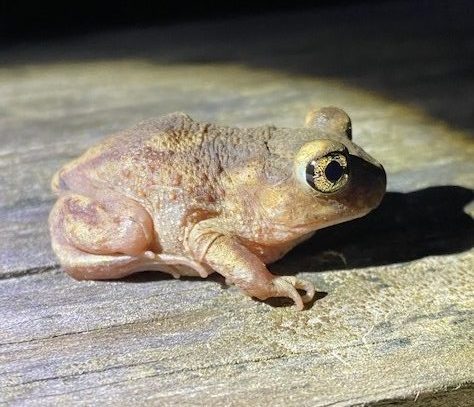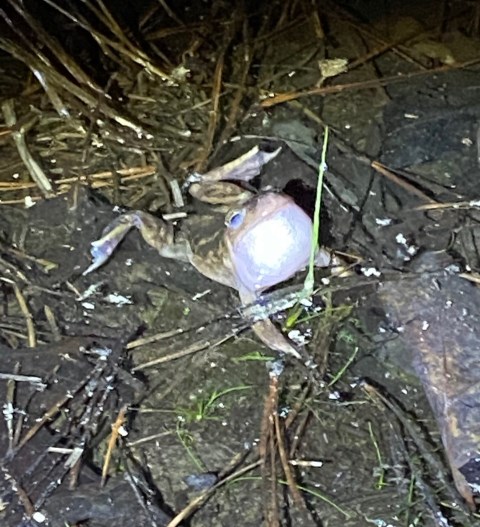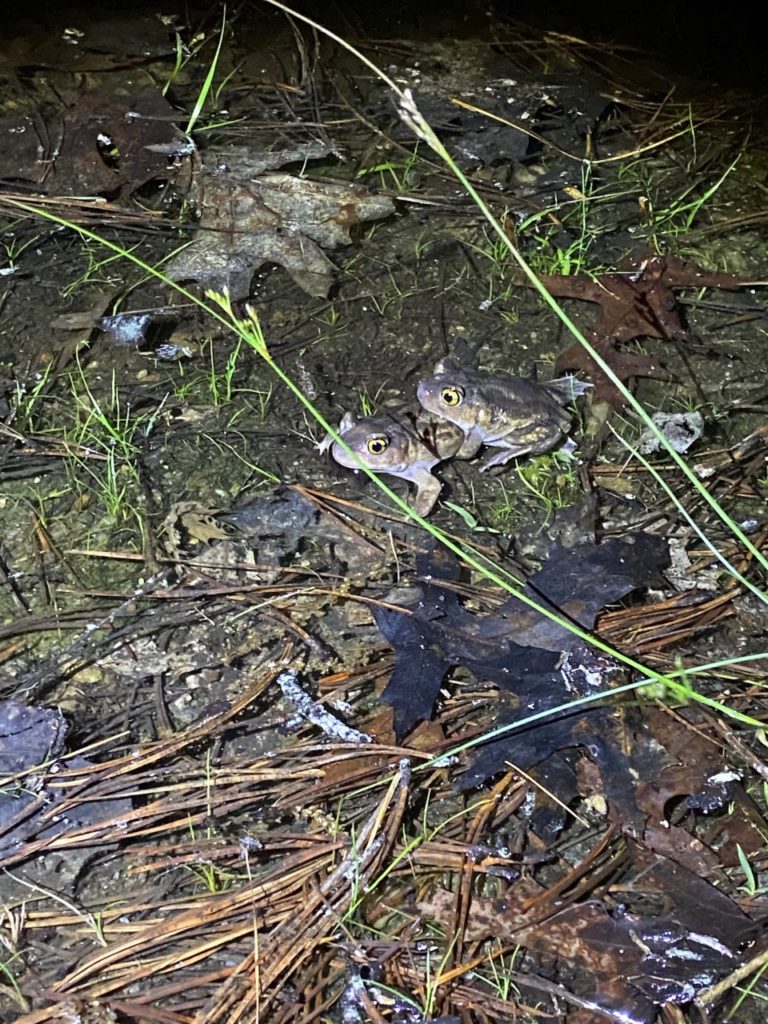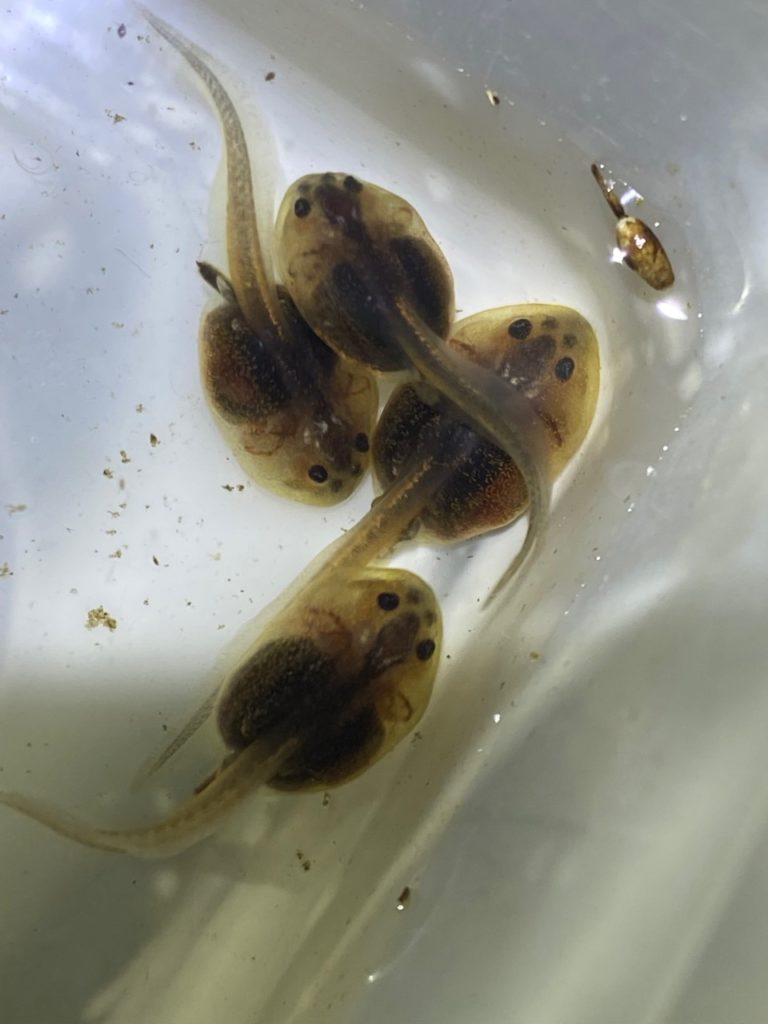After ten long years of dedicated conservation effort by Mass Audubon staff, volunteers, and citizen scientists, the population of eastern spadefoot toads (Scaphiopus holbrookii) translocated to Ashumet Holly Wildlife Sanctuary has finally reproduced!
A pilot project started by Long Pasture Sanctuary director Ian Ives and Bryan Windmiller of Zoo New England was initiated in 2011 to re-establish the species at Mass Audubon’s Ashumet Holly Wildlife Sanctuary in East Falmouth where a native population of spadefoots once existed.

With permission from state wildlife officials, toads from a healthy population at Sandy Neck Barrier Beach in Barnstable were headstarted as tadpoles by partnering with Cape Cod schools. Young toads were then translocated to Ashumet Holly. Over 10 years, 40,000 young toads—or toadlets—were introduced to breeding pools (vernal pools) created specifically for this project. Each year, we monitored the pools for signs that our toads were reproducing, the ultimate goal of any successful conservation program.
“Monitoring is a long and arduous process and you don’t see results in a day or a week or a year,” notes project coordinator Jay Cordeiro. “Long-term monitoring involves measuring hydroperiod (the length of time that there is standing water), assessing toad population demographics and dispersal, estimating survivorship, documenting evidence of breeding, and continued observation once a population has become established.”
We were successful with most of those objectives. But until this summer, there was no evidence of breeding, despite many searches for eggs and tadpoles along with audio recordings “listening” for calling male toads.

2021 brought some favorable conditions. May was the third warmest on record and a band of rain showers provided a good soaking overnight on May 28, prime conditions for spring spadefoot breeding. On May 29, chorusing males were seen and heard for the first time at Ashumet Holly. This was late compared to previous years on the Cape, but followed similar chorusing activity on Barnstable’s Sandy Neck and elsewhere in the state.
It was our first eureka moment!
Male spadefoot toads utilize vernal pools only for breeding, spending most of their lives on land foraging at night and often underground during the day. Presence of active males in the pools is a good indication of readiness to breed. Witnessing this activity was not only unanticipated, but what followed went beyond what was expected once these first individuals made their way down to the pools from upland habitat.
On May 31, toads continued to call in both pools and we saw males and females amplexing (mating embrace of certain amphibians). Another eureka moment.

As exciting as these developments were, we still couldn’t find eggs or tadpoles in either pool. However, on June 13th, project field assistant Sarah Couto observed spadefoot tadpoles in one of the pools. The ultimate milestone!

The only disappointment was that the tadpoles we found did not survive. The reason for the mortality is not clear and we are investigating possible causes.
What made 2021 our breakthrough year? Several factors likely contributed to it. Tadpoles were successfully translocated to this site for seven of the last ten years and a critical density threshold of adults has likely been reached to trigger reproduction. One particular factor that might have been very important to this year’s success was the decision last year to manually scour a few inches of built-up vegetation from the surface of the material lining two manmade vernal pools. Surface plants were absorbing the water faster than the pools could fill and both pools continued to dry prematurely. The scouring enabled the pools to achieve the very specific hydroperiod the toads require— deep enough to support tadpoles, but not too deep to attract numerous invertebrates, which feed on spadefoot tadpoles! Finally, environmental conditions (temperature, rainfall, humidity, etc.) were obviously suitable for breeding this spring at Ashumet.
Project staff and volunteers will continue to monitor the population throughout 2021 and hope for a repeat performance during the 2022 breeding season. We’re thrilled that the establishment of a self-sustaining population of spadefoot toads may well be within reach!
This post was contributed by Jay Cordeiro, spadefoot toad project coordinator at Mass Audubon’s Long Pasture Wildlife Sanctuary.

